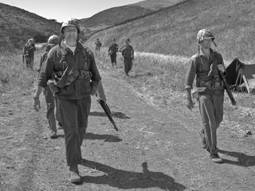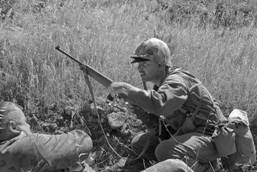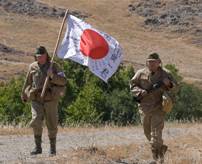|
On June 8, 2008 I had the privilege of spending the day with members of the California Historic Group while they portrayed members of the 1st Marine Division at Camp San Luis Obispo. The CHG is comprised of men and women who keep our history alive though participating in military actions focused on the World War II. These folks devote a great deal of their time and treasure to accurately portray and honor the deeds of the men and women who did so much to preserve our way of life and bring freedom to the world. This particular day the CHG portrayed members of the 1st Marine Division’s actions in Operation Cartwheel, an operation that took place in New Guinea in 1944. What struck me was the attention they pay to details. Even the smallest items, such as the ration packs, are not overlooked. All uniforms, weapons, vehicles and military accessories are provided by the members and they receive no governmental support other than the use of the military base to conduct their maneuvers.
There are hundreds of similar groups across the county keeping our history alive. There are groups on the East Coast portraying soldiers from the Revolutionary and Civil War. There are groups dedicated to keeping the old west alive and groups that portray our once enemies such as the Germans and Japanese. My role on this particular day was to photograph their activities. To do so I was required to dress in the appropriate uniform and follow the rules of the CHG. It really turned out to be both a rewarding and fun day for me and I hope I they will invite me back again soon. To add some historic flavor and drama to the images I have converted some of them to black and white. To view these images click on the image at the left or Click Here. |
|
Men of the 1st Marine Division on the march during Operation Cartwheel maneuvers at Camp San Luis Obispo |
|
Fred Henstridge Photography Takes Part in Operation Cartwheel Exercise |
|
For More Details on Operation Cartwheel Click Here |
|
This exercise would not have been possible without the cooperation of the reenactors who take on the role of the enemy forces. These dedicated men and women are willing to portray German, Japanese or Italian soldiers. Their uniforms and equipment are as authentic as it is possible and they try to demonstrate the enemy tactics as accurately as possible.
During this particular exercise, the Japanese gave the men of the 1st Marine Division quite a fight. They inflected heavy casualties on the Marines right up to the end. Since this group of reenactors was smaller then the group portraying the Marines they had a shorter “Kill” time. Kill time is defined in the Rules of Engagement laid out prior to the exercise. This is the duration the reenactor is sidelined during the exercise. For the Japanese it was five minutes and for the Marines it was fifteen. The “kill” is based on an honor system. If an opposing soldier can see the muzzle flash from an enemy weapon, he can presume himself to be killed. There are also preset ranges for each weapon, e.g. a M1 rifle has a defined range of 100 yards while a Colt 45 caliber pistol has a range of 25 yards . |
|
The Role of the Japanese in the Maneuvers |
|
If you are having problems viewing this page or the graphics please Click Here or to visit our Blog Click Here. |
|
All of the digital images shown on my website were shot with a Nikon D80 with a Nikkor 18-200mm f/3.5-5.6 VR lens or a Nikon Coolpix P5100 digital camera. Kudos to my brother, Bob, for his yeoman work in handling the second camera and getting some great shots. |
|
To remove your name from our mailing list, please click here. Questions or comments? Email us at fhenstridge@henstridgephotography.com or call 951-679-3530 To view as a Web Page Click Here. Please visit our Web Site at http://henstridgephotography.com. |
|
Volume 1, Issue 1, June, 2008 |


|
The Corpsman protects a fallen Marine |

|
Japanese soldiers on the march |
